In the ever-changing world of youth athletics, it is becoming more common than ever for young athletes to participate in a sports performance program. This may be done on their own, with a team or within a school setting, but most young athletes are now engaging in some type of training to enhance athleticism. These programs can have a tremendous impact on a young athlete’s overall development, but they can also be a waste of time, or even worse, dangerous. How do you know what to look for in a quality training program? With coaches hard-selling and boasting about their 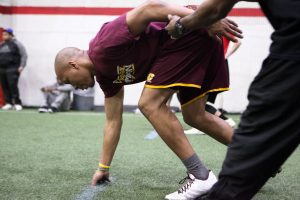 programs, how do you choose the right one?
programs, how do you choose the right one?
There are five key components to look for when seeking out a great sports performance program:
- Culture
- Administration
- The Coaches
- The Program
- Your Goals
Culture
Every coach and/or training center will have a training culture, and it’s important to find the right fit. A culture will contain many things, but young athletes thrive in an environment that encourages fun, positive attitudes, respect and builds self-confidence.
This is especially true for athletes under 14 years old. At this age, it’s important to enjoy the training process so athletes look forward to a more intense environment in the future. Pushing kids too hard – both mentally & physically – at an early age usually results in athletes who dislike training and will often lead to burnout and quitting.
Look for a positive atmosphere where you see plenty of high fives, smiles and coaches “building kids up.” You should see positive reinforcement from the coach and plenty of teaching/instruction.
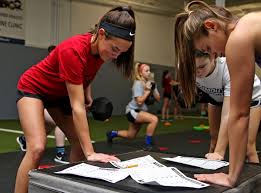 Between 12-14 years old, you might see a more intense sports performance program but the underlying culture should remain the same. There should always be a positive environment with coaches who serve as role models. Athletes should feel good about what they’re doing and praised for their effort.
Between 12-14 years old, you might see a more intense sports performance program but the underlying culture should remain the same. There should always be a positive environment with coaches who serve as role models. Athletes should feel good about what they’re doing and praised for their effort.
The culture is a direct representation of the coach/owner and and the overall intent of the program.
Avoid negative attitudes, high-pressure sales, or unrealistic promises. Not everyone will be attracted to the same culture, but make sure the kids feel comfortable because they’ll be spending a lot of time there.
If there are no quality trainer centers near you, or you simply can’t afford it, find a place that accommodates your needs. This may be a home gym, school weight room or local gym/recreation center. You’ll need adequate space and equipment depending on your goals, so find a place that will suit your needs.
Administration
How do things work with the coach or facility? How do you schedule appointments? What is the coach to athlete ratio? How are the athletes grouped?
All participants in a sports performance program should have the opportunity to thrive in a training environment, and good administration makes sure everything is well organized. This will ensure that you’re engaged with professionals who take this important job seriously.
Have you heard other people talk about training at a facility or with a coach? What was their experience? Have other athletes had success with the program? Athletes who have gone through a program should have positive things to say about it.
Do a little research to see what kind of track record a program has. Testimonials are helpful, but talking to someone you know can give you even more insight.
When observing a class you’ll want to see participants of similar ages/abilities together and interacting appropriately. This does not mean that every athlete in a group needs to be the same age or play the same sport, but the training goals should be similar or the coach should know how to modify the program for each athlete. Cookie-cutter programs aren’t always bad, but an individualized approach is always preferred.
Look for a relatively low coach to athlete ratio. A good coach can easily handle 20+ athletes in a team environment, but there should be a much lower ratio for a more individualized program. Smaller groups ensure more individual feedback, but most athletes thrive in groups. This is especially true for young athletes so that games and group activities can be utilized. A 1-on-1 session for a 9 year old has the potential to get pretty boring for the athlete. Being in groups also gives young athletes the opportunity to develop character traits such as leadership, teamwork, giving encouragement, empathy and respect. These things are much easier to address in a group setting.
The Coaches
Quality coaches are the most important thing to look for in a sports performance program. Coaches pretty much make or break a program, so make sure you’re with a good one. Not only will a good coach get performance results, but they should also address things like motivation, mindset, respect and the value of hard work.
Make sure that your coach is certified from a well known & respected organization such as the IYCA or NSCA. He/she should also have experience coaching athletes, and a proven track-record of producing results is definitely preferred.
A degree in a related field (kinesiology, exercise science, physical education, etc.) is highly recommended, but there are a lot of exceptional youth coaches who got their education after receiving a college degree in an unrelated field. The coaches should have positive energy, be strong role models, and truly enjoy helping athletes develop.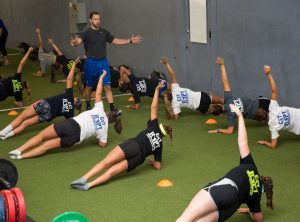
Like culture, people are drawn to certain personalities or coaching styles, and it’s important you find the right fit. Have a conversation with the coach or staff to see if you get along and more importantly if your child gets along with the coach.
The coach has to earn your trust as does your child. This trust will allow for proper growth of the athlete and continual trust in the program will also allow the coach to push the athlete to their potential.
Try not to get overwhelmed by past athletic accomplishments or a coach’s physique. While certainly not negatives, these things don’t necessarily mean he/she has the educational background or coaching ability to help you. It usually helps to have a coach who has some degree of athletic experience, but this should not be their #1 qualification.
Some coaches are able to really utilize their experiences to benefit young athletes, while others were simply born with talent. So, take it into consideration (because it’s important), but try not to let it cloud your judgement if nothing else feels right.
If the facility has a large staff, don’t hesitate to request a coach your child loves, or ask to NOT train with someone your child really doesn’t like. This may not always happen, but a good program will make an effort to accommodate your needs.
Disrespectful or inappropriate comments or actions are a definite red flag. Having a negative coach in a child’s life can cause tremendous stress and can hard a child’s self-esteem and enjoyment of the training process. While it is sometimes necessary to be firm or have difficult conversations, good coaches can handle tough situations professionally.
Athletes who don’t live anywhere near a training facility now have online options available that will allow you to train at home. While this option may not be as optimal as having a live coach, it’s often the only option available. It can also be much less expensive and more convenient, so there are certainly reasons an athlete may choose to train alone.
Finding a great home-based sports performance program can be tricky, because every trainer with a web-site or social media presence may tell you this is an option. Just like looking for an in-person trainer, look for credentials, experience, values, and a proven track record. Make sure you have the equipment necessary to complete an at-home program. We’ll discuss at-home programs in much greater depth in the future, but consider it a second-tier option.
The Program
The actual training program is critical, but usually difficult for parents to truly understand. You won’t know precisely what the program will include, which is why it’s so important to find a qualified coach.
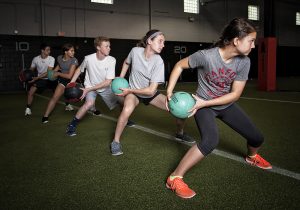 At a minimum, a good sports performance program should be very safe and organized. Sure, accidents happen, but a young athlete’s health is top priority, so they should never be engaged in anything dangerous.
At a minimum, a good sports performance program should be very safe and organized. Sure, accidents happen, but a young athlete’s health is top priority, so they should never be engaged in anything dangerous.
In general, if it doesn’t look safe, it probably isn’t. Kids may get sore and tired, but they shouldn’t sustain injuries from a training program.
The program should have a basic level of individualization, or at least include the opportunity for modification when appropriate. Most young athletes have a lot of the same needs, so there will be a great deal of similarity between programs for athletes, but the program should be flexible enough to address individual needs when needed.
Most programs will address strength, running mechanics, jumping, fitness, mobility, agility, and coordination. Make sure the program is meeting your individual goals and that the coaches modify their program to help achieve those goals. At the very least, you should be able to receive an explanation of how and why the program will help work toward your goals.
There should be a great deal of teaching, instruction and feedback given, and there should be a progression to everything that is done. This means that the program will gradually get more demanding.
The weight lifted, the volume of overall exercise and the intensity of the drills should gradually increase. We know that progressions or progressive overload is key to not only a younger athlete but more importantly to all athletes. Progressive overload is the principal in which each week you are progressively getting stronger our advancing toward a new technique. There should not be an emphasis on how much you can lift but how much progress is being made.
There is an old saying that the program should have the athlete conform to the program but actually, the program should conform to the athlete. You want to ask questions about the program including expected results and core values in programming.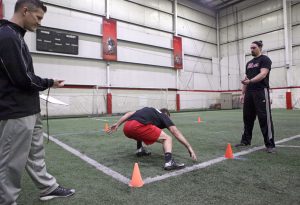
There should always be some sort of assessment to determine needs and establish baselines. This assessment will vary, but the coach should talk to you about the results and formulate a program based on those results.
An assessment like the IYCA Big 5 or FMS will help find deficiencies and areas of concern, and a performance assessment will help establish baselines and give the coach a better understanding of how the athlete moves. It’s always great if there is a movement analysis using video of the athlete performing various movements.
While the programs will vary greatly, it helps to hear about results from other athletes and ensure that the coaches are qualified.
Again, if you are looking for an at-home program, be sure you are getting what you need. Don’t try to replicate a D1 college football program with an 11-year old kid who has never lifted weights. Find a program that is specific to your goals & experience level, has delivered results, and is created by an experienced coach or organization.
Goals
Goal setting is crucial for any athlete, and it should be a part of a sports performance program. Make sure that your goals align with the facility and their goals for you child. Training is an investment of time and energy, and it’s not uncommon for young athletes to spend several years training at a facility. You want to make sure they understand your long-term goals, so they are invested in your success and development.
For example, there are some facilities/programs that focus exclusively on strength development. If your goal is to run faster, this is probably not the right place for you. Typically, a sports performance training program will be able to address multiple goals – speed, strength, mobility, conditioning, etc. – but you want to make sure to ask if there is a program to specifically address your goals.
Teaching goal setting, and the process of working toward goals is a skill that will serve athletes well in all facets of life. Let them dream, let them strive for success. In a world so based on technology, having goals can help set them up for success. It’s even a great idea to include non-sports related goals such as academic or personal goals. Remember, a student-athlete is always a student first, so keep that in mind when setting goals.
Selecting a sports performance program or facility is an important choice – perhaps more important than you think – and there are many things to consider. The five components outlined here should help in your decision making process. From the culture to the facility to the coaches themselves, you want to make sure you find a place that is comfortable, fun, engaging and creates programs that help the athlete move toward their goals. Ask questions, talk to others and hopefully you’ll end up finding a comfortable fit for a long time.
About the Author: Brad Leshinske is the founder of the Athletic Edge Sports Performance program in Chicago and an adjunct faculty member at North Park University. He has more than 10 years of experience training athletes of all ages and at every level of competition.

To learn about sports performance from 17 of the top strength & conditioning professionals in the business, be sure to check out the IYCA’s Principles of Athletic Strength & Conditioning textbook.

